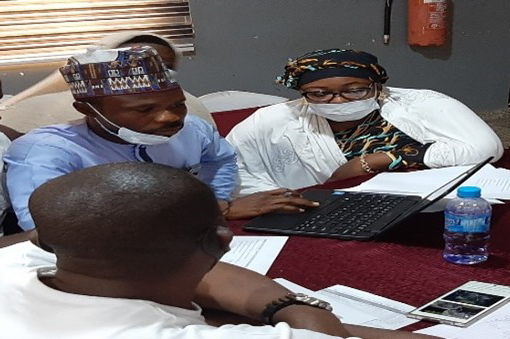Health Management Information System Use in Jummai Babangida Antenatal and Maternal Care (JBAM) Hospital, Minna, Niger State
Background
In August 2020, Health Strategy and Delivery Foundation (HSDF) conducted a Performance of Routine Information System Management (PRISM) assessment of the Niger Health Management Information System (HMIS). To bridge the gaps identified in the assessment, the state, with support from HSDF, adopted the HMIS information use intervention.
The first action point after the assessment was the training of health data managers across relevant ministries, departments, and agencies (MDAs) in the state. Following the training sessions, HSDF selected two general hospitals and two Primary Healthcare Centers (PHCs) from two LGAs ─ Chanchaga and Suleja, in a pilot study to support their monthly performance review meetings.
Collaborating with the state, HSDF developed and instituted a process where facility data review is conducted independently, before LGA and state data validation meetings. These facility data reviews aim to improve data quality, ultimately improving service delivery and decision making at the facility level.

Reasons for HMIS Information Use Intervention
Findings from the PRISM assessment in Niger State revealed the lack of a performance management platform for data validation, review, and use. This has continued to affect the quality of data generated and information used for decision-making at all administrative levels assessed.
Data quality assessments are conducted to carry out data quality assurance on generated data. This will include checking for four data quality dimensions, which include completeness, timeliness, accuracy, and consistency.
Specific objectives of performance review meetings include:
- Routine data use for enhanced efficiency, quality, and targeting of health services
- Innovation of strategies for improving the quality of data
- Basis for planning and developing interventions
- Allows providers to identify patients/clients in need of services and/or referrals
- Improved efficiency of the organization
- Proper management of inventories, resources, supplies, and medicines that are available and those needed to be ordered and when

Progress of Key Maternal Health Indicator at JBAM Hospital, Minna
Following the HMIS information use intervention, the hospital’s management began to provide free Intermittent Preventive Treatment (IPT) of malaria for pregnant women at their first Antenatal visit. The percentage of pregnant women attending ANC who receive IPT 1 increased from 0% to 57% over eight months of intervention in the state.

By HSDF’s Data and Performance Management Team
Grants and Business Development Specialist
We are seeking a highly motivated and experienced Grants and Business Development Specialist to join our organization. The successful candidate will be responsible for identifying funding opportunities, developing grant proposals, and fostering partnerships with potential donors and stakeholders (regional and global). This role plays a vital part in securing funds and resources to support our organization’s mission and projects.
Apply NowPublic Health Consultant, Guinea
The consultant (working with the Accelerator team) will collect results from the tool, organize a meeting with stakeholders to discuss results from the tool, and produce a report on key findings and recommendations from the tool to be shared publicly.
Apply NowPublic Health Associate, Senegal
We are currently in search of an experienced Public Health professional in Senegal to work on the anticipated Nutrition Capacity Development and Financing Platform and provide technical assistance to elevate nutrition financing and strengthen local capacity to support these efforts. The Associate must be bilingual (English and French).
Apply Now